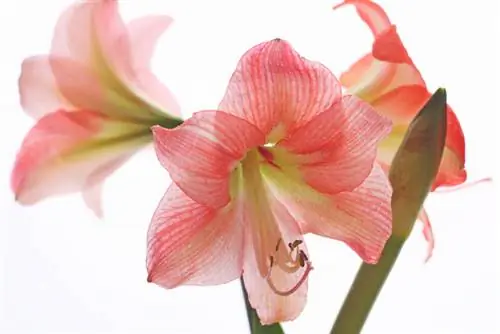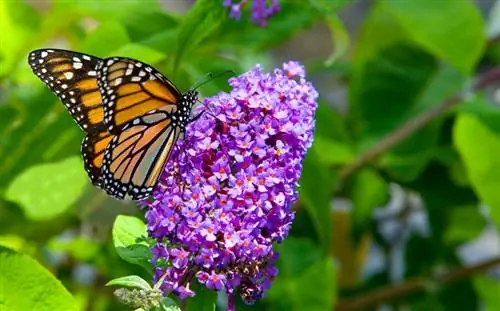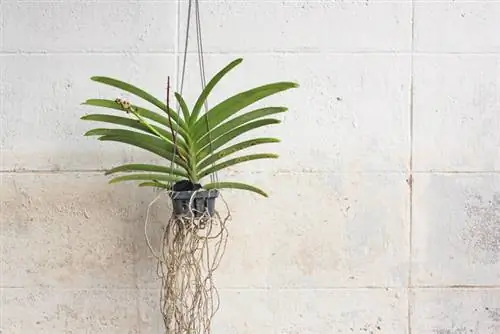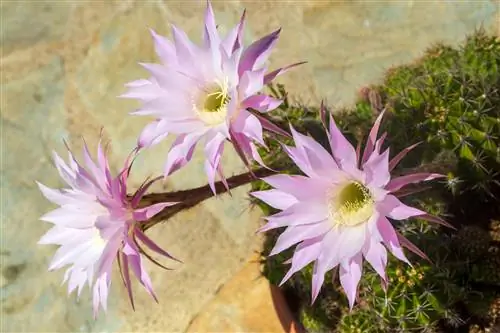- Author admin [email protected].
- Public 2023-12-16 16:46.
- Last modified 2025-06-01 06:02.
When we talk about an amaryllis in common parlance, it is usually a knight's star. The subtropical onion flower impresses as a houseplant with its winter flowers. Cultivation therefore follows an opposite vegetation cycle, which can be easily mastered with a little rethinking. These care instructions provide answers to all important questions.

How do you properly care for an amaryllis?
To properly care for an amaryllis, water moderately until budding, keep the substrate constantly moist during flowering and reduce the water supply in summer. Fertilize every 14 days during the growth phase and cut off faded flowers. Rest periods and repotting are essential for renewed flower formation.
How do I water the amaryllis correctly?
The water requirement increases in proportion to growth and is then reduced to a minimum towards dormancy. How to water an amaryllis correctly:
- After planting, water moderately until budding
- Keep the substrate constantly moist during the flowering phase (December to February)
- Gradually reduce the water supply during the summer growth phase (March to July)
- Stop watering while the plant is resting (August to October)
After you repot the flower bulb in November, the vegetation cycle begins again. Please only use soft water or collected, filtered rainwater. To reduce the risk of rot on the tuber, please add the water to the saucer.
When and how should a Ritterstern be fertilized?
The supply of nutrients to an amaryllis only begins at the end of the flowering period. From this point on, fertilize every 14 days with a liquid fertilizer for tropical flowering plants (€8.00 on Amazon). Under normal conditions, the fertilization phase extends over the months of April/May to July/August.
How do I care for the amaryllis after flowering?
In order for these care instructions to result in a recurring amaryllis flower, it is important to handle it professionally after flowering. How to do it right:
- Cut off wilted flowers as soon as possible
- Continue watering throughout the summer
- Fertilize liquidly every 14 days until July
After you stop watering in August, the leaves will grow in completely. During the rest period, cut off the foliage. The knight's star stays in the dark cellar at a cool 15 degrees Celsius to gather fresh strength for the next flowering period.
Cut the leaves - yes or no?
After you have cut off the withered flower heads, the summer growth phase begins for the Ritterstern. The care program continues seamlessly, supplemented by a dose of liquid fertilizer every 2 weeks. The leaves play a key role in this interaction and must not be cut off. Only when the Ritterstern is no longer watered and fertilized from August onwards will the flower bulb pull in its foliage. In September/October you can then remove the leaves without worry.
How do I repot a Ritterstern correctly?
At the end of dormancy, give your Ritterstern a new lease of life by properly repotting the bulb in fresh substrate. After the plant has been able to regenerate in dry soil in the dark, cool cellar, the starting signal for the next winter flower festival is given in November. Please wear gloves to carry out the work in this sequence:
- Fill a stable, stable flower pot with a mix of standard soil and horn shavings
- Previously create a 2 cm high drainage layer made of broken clay or expanded clay above the water drain in the ground
- Unpot the knight's star to cut off the drawn leaves and visibly dried roots
- Only insert the bulb deep enough into the substrate so that the top half is not covered with soil
Press the substrate firmly with your hands and water. It is an advantage if you pour the soft, room temperature water into the saucer. Due to capillary force, the moisture is drawn into the substrate without the exposed part of the flower bulb getting wet. The coaster can then be emptied after 10 minutes.
What diseases is an amaryllis threatened by?
Its high poison content does not protect the knight's star from disease. It is specifically the following two fungal infections that can cause you headaches when it comes to care. We have put together important details about symptoms and possible control methods for you here:
Red Burner (Anthracnose)
Visible symptoms are red leaf spots with a yellow edge that extend to the flower bulb. As the spots progress, they flow into one another. The foliage turns brown and the stem rots. Cut out burnt plant parts and dust the cut areas with charcoal powder. As a preventive measure, care should be taken to ensure that the exposed part of the onion is not wetted with water.
Leaf spot (Septoria)
This fungal disease also manifests itself in the form of red leaf spots. These differ from the Red Burner in that they have a red border and are transparent. Cut off infected leaves and dispose of them in household waste. Since a warm, humid microclimate offers ideal living conditions for the fungal spores, a change to a cool, dry location is recommended.
Tip
A knight's star also thrives magnificently in hydroculture. In this variant, the thick flower bulbs are completely covered with clay balls. A perfect solution explicitly for beginners, as the somewhat delicate water balance of the South American flower beauty can be easily regulated.






